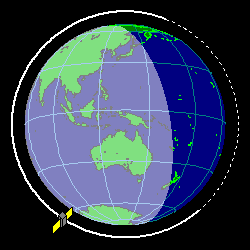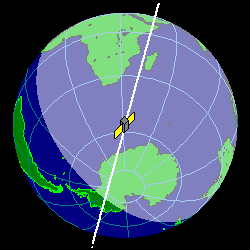Envisat orbit
Choice of orbit
The selection of a sun-synchronous orbit was of primary importance and has driven the satellite's physical configuration. The total altitude range, within a few tens of kilometres of 800 km, was also critical to the design. Apart from this, there was a certain degree of freedom in the choice of parameters. Many of the choices were examined during the ERS-1 mission preparation and the concept of the multidisciplinary orbit, with a 35-day cycle, evolved. Envisat flies this same high-inclination, sun-synchronous, near-circular orbit with the same ground track.
Orbit maintenance
The orbit maintenance requirements are that the deviation of the actual ground track from the nominal one is kept below 1 km and that the mean local nodal crossing time matches the nominal one to within five minutes. The orbit maintenance strategy aims for minimum disturbance of the payload operation. In-plane manoeuvres are used for altitude adjustment to compensate for the effects of air-drag. This altitude decay affects the ground-track repeatability, mainly in the equatorial regions. The frequency of these manoeuvres is determined by the rate of orbital decay, which in turn is determined by the air density, and this is a function of solar activity. The nominal rate for these in-plane manoeuvres is twice a month. They do not interrupt the operations of most sensors. Out-of-plane corrections are used to rectify the steady drift of inclination mainly caused by solar and lunar gravity perturbations. The solar wind also influences inclination, but its contribution is typically an order of magnitude smaller than the one made by solar and lunar gravity. Inclination drift degrades ground-track maintenance at high latitudes. The drift rate does not depend on air density and corrections are required every few months. As they are out-of-plane they require a 90 degree rotation of the spacecraft, to align the thrusters with the required thrust direction, so these manoeuvres are performed in eclipse to avoid the risk of optical sensors viewing the sun.
Orbit parameters
| Main characteristics | extension orbit | first orbit |
|---|---|---|
| Semi-major axis | 7142.0 km | 7159.5 km |
| Eccentricity | 0.001158 | 0.001165 |
| Inclination (sun-synchronous) | 98.55° | 98.55° |
| Auxiliary data | ||
| Reference altitude (equatorial) | 782.4 km | 799.8 km |
| Nodal period | 100.59 min | |
| Repeat cycle | 30 days | 35 days |
| Number of passes per cycle | 862 | 1002 |
| Ground track separation at Equator | 80 km | |
| Acute angle at Equator crossings | ||
| Longitude at Equator of pass 1 | ||
| Orbital velocity | 7.45 km/s | |
| Ground scanning velocity |







